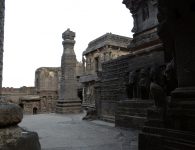On this 30th day of our journey, we drove from Dehradun, the capital of Uttarakhand, to the unoffical capital of the Tibetans in Exile – Dharamshala, in the state of Himachal Pradesh.
We started from Dehradun where we paid homage to national institutions of the Defence forces and drove through Nahan to Shimla, the capital of Himachal Pradesh.
We then drove through the state to Mandi, the famous valley town in Kulu Valley on the banks of the great Beas river. We visited the local Bhootnath temple and also saw the palace belonging to the Raja of Mandi.
During this drive we realised how clean the state was and even at the high altitudes the roads were excellent. We then drove through a full moon light night towards the Dhaulandhar range of Himalayas and spotted our first snow in moon light, it inspired Bhairavi to write a poem.
Origin: Dehradun, Uttarakhand
Destination: Dharamshala, Himachal Pradesh
Distance Covered: 500 Kms
States Covered: Uttarakhand, Himachal Pradesh
The Rajmahal Palace: During the state time this entire complex was the Royal guest House where other Royalties making a state visit would stay. The Royal Family still reside in the main part of this palace complex which is private. Mrs. Indira Gandhi, Lord & Lady Mountbatten, Mr Roerich (the famous Russian painter), His holiness The Dalai Lama and others have stayed here.
The Bhootnath Temple: Bhootnath Temple, with an idol of a manifestation of god Shiva, an ancient temple dated to the 1520s, is synonymous with Mandi. It is in the heart of the town. The Nandi, Shiva’s mount, faces the deity from the ornamented double-arched entrance. The festival of Shivaratri is the prime event at this temple; the temple is the focal point of the seven day festival. We met the Chief Priestess and interviewed her.
River Beas: The Beas River marks the eastern-most border of Alexander the Great’s conquests in 326 BC. It was one of the rivers which created problems in Alexander’s invasion of India. His troops mutinied here in 326 BCE, refusing to go any further; they had been away from home for eight years. Alexander shut himself in his tent for three days, but when his men did not change their desires he gave in, raising twelve colossal altars to mark the limit and glory of his expedition. This river criss-crosses the highway at many places.
Interview with the priestess at the Mandi Temple.
Interview with a mother and daughter on a scooter in Mandi, on the road in front of the temple.




No comments